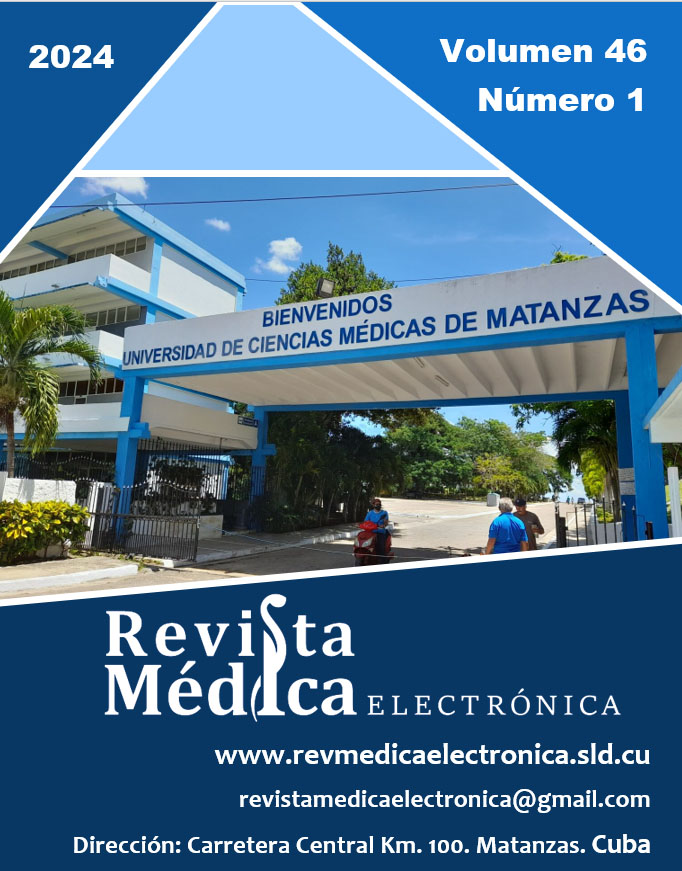Perception of the probability of post-vaccination death due to a resurgence of SARS-CoV-2 in Peru
Keywords:
contagion, COVID-19, efficacy, perception, vaccinationAbstract
Introduction: The resurgence of COVID-19 cases in Peru has intensified people’s concerns about a new vaccination.
Objective: To describe the perception of the probability of post-vaccination death due to new cases of SARS-CoV-2 in Peru.
Methods: Between January and March 2024, a study was conducted in Ica, Peru, with 28 university professors vaccinated with three vaccine doses, the first two from Pfizer-BioNTech. Those with mixed vaccination and those who showed doubts about the healthcare system were excluded. The study calculated the proportion of professors with a uniform vaccination scheme, applying a Likert scale and measuring internal consistency with Cronbach's alpha coefficient.
Results: The female group slightly outnumbered the male group at 61.54%; the most representative age range was 45 to 54 years old. 46.43% received three doses of the Pfizer-BioNTech vaccine. Only 14% were willing to undergo revaccination, despite high confidence in health information (89%). The value of the Likert scale was 2.94 points, which suggested a diversity of opinions. Cronbach's alpha coefficient of 0.94 indicated excellent internal consistency.
Conclusions: There was diversity in the attitudes of university professors about vaccination. Although the majority trusted the healthcare system, there is skepticism towards the effectiveness of vaccines and limited willingness to receive additional doses in the face of COVID-19 resurgence.
Downloads
References
2. Wu Z, McGoogan JM. Characteristics of and important lessons from the coronavirus disease 2019 (COVID-19) outbreak in China: Summary of a report of 72314 cases from the Chinese Center for Disease Control and Prevention. JAMA. 2020;323(13):1239-42. DOI: 10.1001/jama.2020.2648.
3. Huang X, Wei F, Hu L, et al. Epidemiology and clinical characteristics of COVID-19. Arch Iran Med. 2020;23(4):268-71. DOI: 10.34172/aim.2020.09.
4. Chan JFW, Yuan S, Kok KH, et al. A familial cluster of pneumonia associated with the 2019 novel coronavirus indicating person to person transmission: a study of a family cluster. Lancet. 2020;395:514-23. DOI: 10.1016/S0140-6736(20)30154-9.
5. Huang C, Wang Y, Li X, et al. Clinical features of patients infected with 2019 novel coronavirus in Wuhan, China. Lancet. 2020;395:497-506. DOI: 10.1016/s0140-6736(20)30183-5.
6. Oliveira Roster KI, Kissler SM, Omoregie E, et al. Surveillance strategies for the detection of new SARS-CoV-2 variants across epidemiological contexts. medRxiv. 2023. DOI: 10.1101/2023.05.09.23289744.
7. Wohl S, Lee EC, DiPrete BL, et al. Sample size calculations for pathogen variant surveillance in the presence of biological and systematic biases. Cell Reports Medicine. 2023;4(5):101022. DOI: 10.1016/j.xcrm.2023.101022.
8. Badr HS, Zaitchik BF, Kerr GH, et al. Unified real-time environmental-epidemiological data for multiscale modeling of the COVID-19 pandemic. Scientific Data. 2023;10(367). DOI: 10.1038/s41597-023-02276-y.
9. Voysey M, Costa Clemens SA, Madhi SA, et al. Single-dose administration and the influence of the timing of the booster dose on immunogenicity and efficacy of ChAdOx1 nCoV-19 (AZD1222) vaccine: a pooled analysis of four randomised trials. Lancet [Internet]. 2021 [citado 26/03/2024];397(10277):881-91. Disponible en: https://pubmed.ncbi.nlm.nih.gov/33617777/
10. Kow CS, Hasan SS. Real-world effectiveness of BNT162b2 mRNA vaccine: a meta-analysis of large observational studies. Inflammopharmacology [Internet]. 2021 [citado 26/03/2024];29(4):1075-90. Disponible en: https://pubmed.ncbi.nlm.nih.gov/34241782/
11. Meggiolaro A, Sane Schepisi M, Nikolaidis GF, et al. Effectiveness of vaccination against SARS-CoV-2 infection in the pre-delta era: A systematic review and meta-analysis. Vaccines. 2022;10(2):157. DOI: 10.3390%2Fvaccines10020157.
12. El Comercio. Denuncian que aplican vacunas expiradas contra la COVID-19 y Minsa responde que proceso es seguro [Internet]. Lima: El Comercio; 2024 [citado 13/02/2024]. Disponible en: https://elcomercio.pe/lima/covid-19-ciudadanos-denuncian-que-aplican-vacunas-expiradas-y-minsa-responde-que-proceso-es-seguro-ultimas-noticia/?ref=ecr
13. Polack FP, Thomas SJ, Kitchin N. Safety and Efficacy of the BNT162b2 mRNA Covid-19 vaccine. New England Journal of Medicine. 2020;383(27):2603-615. DOI: 10.1056/NEJMoa2034577.
14. Logunov DY, Dolzhikova IV, Shcheblyakov DV, et al. Safety and efficacy of an rAd26 and rAd5 vector-based heterologous prime-boost COVID-19 vaccine: an interim analysis of a randomised controlled phase 3 trial in Russia. Lancet. 2021;397(10275):671-81. DOI: 10.1016/S0140-6736(21)00234-8.
15. Dagan N, Barda N, Kepten E, et al. BNT162b2 mRNA Covid-19 vaccine in a nation wide mass vaccination setting. New England Journal of Medicine. 2021;384(15):1412-23. DOI: 10.1056/NEJMoa2101765.
16. Thompson MG, Burgess JL, Naleway AL, et al. Interim Estimates of Vaccine Effectiveness of BNT162b2 and mRNA-1273 COVID-19 Vaccines in Preventing SARS-CoV-2 Infection Among Health Care Personnel, First Responders, and Other Essential and Frontline Workers — Eight U.S. Locations, December 2020–March 2021. MMWR. 2021;70(13):495-500. DO: 10.15585/mmwr.mm7013e3.
17. Cronbach LJ. Coefficient alpha and the internal structure of tests. Psychometrika. 1951;16(3):297-334. DOI: 10.1007/BF02310555.
18. Heinzerling A, Stuckey M, Scheuer T, et al. Transmission of COVID-19 to health care personnel during exposures to a Hospitalized Patient - Solano County, California, February 2020. MMWR. 2020;69(15):472-6. DOI: 10.15585/mmwr.mm6915e5.
19. Arboleda R, Mace Firebaugh CJ, Beeson T, et al. Demographic factors associated with COVID-19 vaccine perceptions amongst healthcare and law enforcement workers. J Contemp Stud Epidemiol Public Health. 2023;4(1). DOI: 10.29333/jconseph/12935.
20. Haddar A, Sellami I, Abbes A, et al. Vaccination day and perceived stress among university teachers. European Psychiatry. 2022;65(S1):S542-3. DOI: 10.1192/j.eurpsy.2022.1388.
21. Zheng C, Shao W, Chen X, et al. Real-world effectiveness of COVID-19 vaccines: a literature review and meta-analysis. International Journal of Infectious Diseases. 2022;114:252-60. DOI: 10.1016/j.ijid.2021.11.009.
22. Peres IT, Bastos LSL, Gelli JGM, et al. Sociodemographic factors associated with COVID-19 in-hospital mortality in Brazil. Public Health. 2021;192:15-20. DOI: 10.1016%2Fj.puhe.2021.01.005.
23. Cesareo M, Tagliabue M, Lopes ME, et al. Framing effects on willingness and perceptions towards COVID-19 vaccination among university students in Italy: An exploratory study. Vaccines. 2023;11(6):1079. DOI: 10.3390/vaccines11061079.
24. Wong JCS, Yang JZ. Risk perception of the COVID-19 vaccines: revisiting the psychometric paradigm. Journal of Risk Research. 2023;26(6):697-709. DOI: 10.1080/13669877.2023.2208142.
25. Rahayuwati L, Mutyara K, Nugraha RR, et al. COVID-19 vaccine perspective among university lecturers and students: A qualitative study of pre implementation of vaccination. Journal of Multidisciplinary Healthcare. 2023;16:1619-29. DOI: 10.2147/JMDH.S416123.
Downloads
Published
How to Cite
Issue
Section
License
All content published in this journal is Open Access, distributed under the terms of the CC BY-NC 4.0 License.
It allows:
- Copy and redistribute published material in any medium or format.
- Adapt the content.
This will be done under the following terms:
- Attribute the authors' credits and indicate whether changes were made, in which case it must be in a reasonable way.
- Non-commercial use.
- Recognize the journal where it is published.
The copyrights of each article are maintained, without restrictions.






